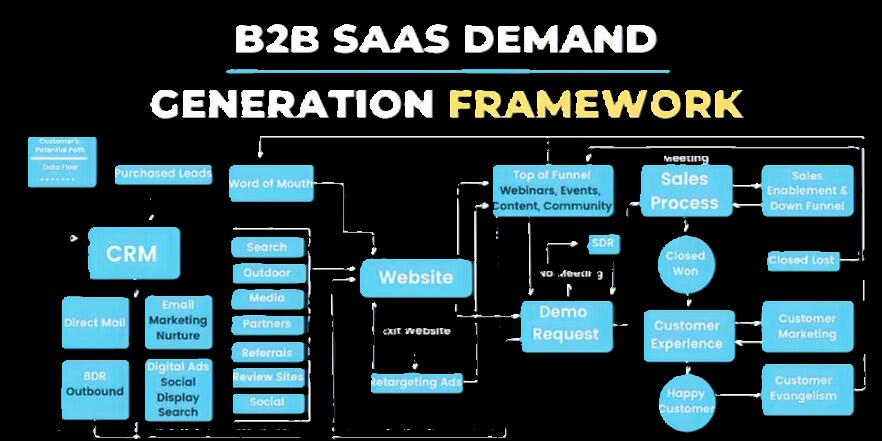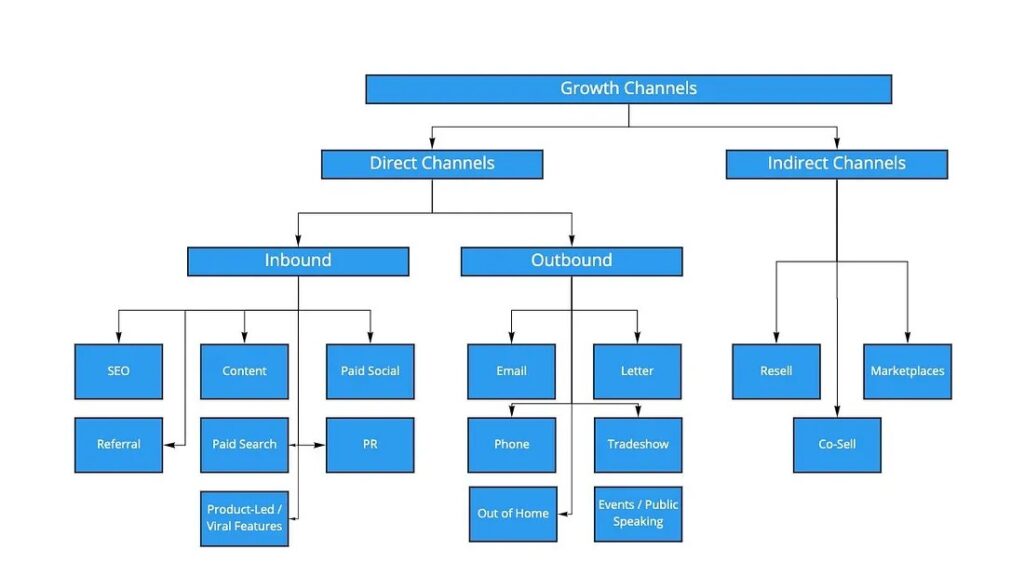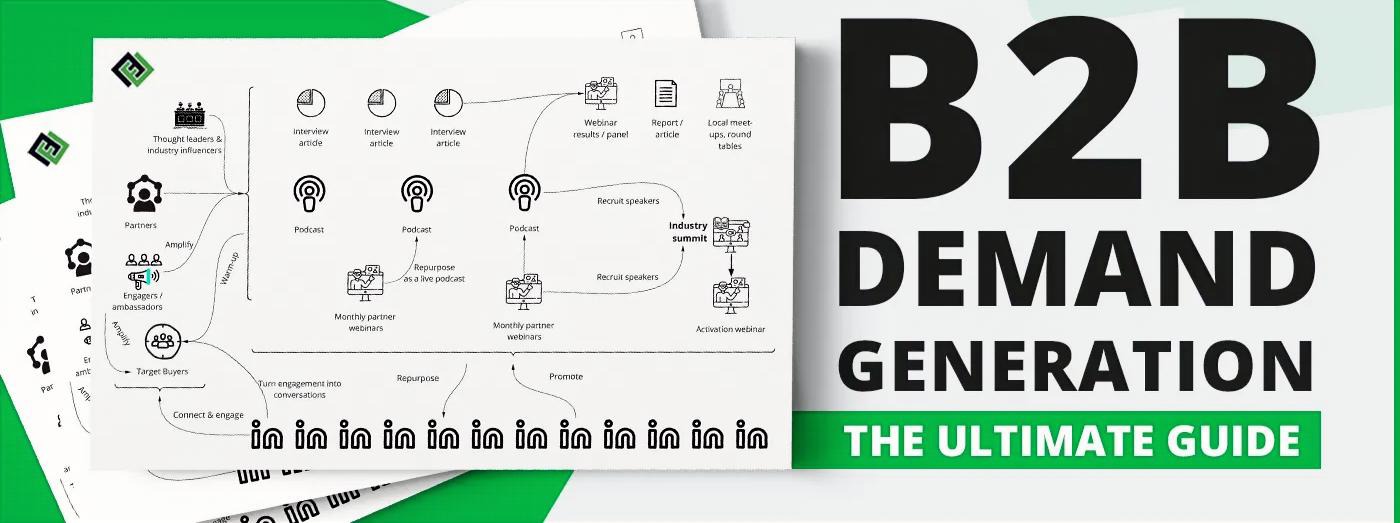Growing a successful B2B SaaS business in 2025 isn’t about outspending competitors on ads. It’s about building genuine trust, delivering consistent value, and creating systems that turn prospects into advocates.
This comprehensive playbook is designed for founders, marketing leaders, and growth teams who want to build sustainable demand generation engines that drive predictable revenue growth.
Table of Contents
- The Current State of B2B Demand Generation
- How Modern B2B Buyers Have Evolved
- Core Principles of Effective Demand Generation
- The Complete Demand Generation Framework
- High-Impact Channels and Tools
- Critical Mistakes to Avoid
- Real-World Success Stories
- Implementation Timeline
- Frequently Asked Questions

The Current State of B2B Demand Generation
The B2B buying landscape has fundamentally shifted. Today’s digital-first environment demands a completely different approach to demand generation.
Key Market Dynamics:
- 83% of B2B sales interactions now happen in digital channels
- 67% of the buyer’s journey is completed independently before engaging with sales
- Average buying committees include 6-10 stakeholders across different departments
- 54% of buyers spend more time researching purchases than ever before
This shift means traditional interrupt-based marketing is losing effectiveness. Instead, successful companies are building systems that attract, educate, and nurture prospects throughout their entire buying journey.
How Modern B2B Buyers Have Evolved
Today’s B2B buyers are fundamentally different from those of even five years ago. They’re more informed, more skeptical, and more demanding of value before they’ll engage.
The Modern B2B Buyer Profile:
Information-Driven Decision Making
- 95% of buyers choose vendors who provide helpful content during the research process
- 70% of buyers consume 3-5 pieces of content before engaging with sales
- 88% of buyers want to see case studies and proof points before making decisions
Trust-First Approach
- 81% of buyers need to trust a brand before they’ll consider purchasing
- 73% of buyers are more likely to purchase from companies that demonstrate industry expertise
- 64% of buyers want to see transparent pricing and clear value propositions
Self-Service Expectations
- 75% of buyers prefer to research and evaluate options independently
- 68% of buyers want access to free trials or freemium versions
- 59% of buyers expect immediate access to information without gating

Core Principles of Effective Demand Generation
Successful demand generation in 2025 is built on three fundamental principles that guide every strategic decision:
1. Value-First Approach
Lead with education, insights, and solutions rather than product features. Your content should solve problems before it sells solutions.
2. Systematic Consistency
Sporadic efforts don’t build momentum. Consistent, high-quality touchpoints across all channels create compound growth effects.
3. Buyer-Centric Journey Design
Meet prospects where they are in their buying process, not where you want them to be. Design experiences around their needs, not your sales process.
The Complete Demand Generation Framework
Phase 1: Foundation Building (Months 1-3)
Content Strategy Development
- Conduct comprehensive keyword research using tools like Ahrefs or SEMrush
- Create detailed buyer personas based on customer interviews and data analysis
- Develop a content calendar focusing on long-tail, problem-solving keywords
- Establish your unique point of view and thought leadership angle
Technical Infrastructure
- Implement marketing automation platform (HubSpot, Marketo, or Pardot)
- Set up comprehensive analytics tracking (Google Analytics 4, heat mapping tools)
- Optimize website for mobile responsiveness and page speed (target: under 3 seconds)
- Create lead magnets and conversion-optimized landing pages
Phase 2: Content and SEO Optimization (Months 2-6)
High-Impact Content Creation
- Publish comprehensive guides that address specific buyer challenges
- Create comparison articles targeting “[competitor] vs [your solution]” keywords
- Develop case studies that showcase measurable business outcomes
- Build interactive tools or calculators that provide immediate value
Technical SEO Excellence
- Optimize title tags and meta descriptions for click-through rates
- Implement structured data markup for rich snippets
- Build high-quality backlinks through guest posting and digital PR
- Create topic clusters linking related content pieces
Phase 3: Multi-Channel Activation (Months 3-9)
LinkedIn Strategy
- Develop a consistent posting schedule (3-5 times per week)
- Engage authentically in industry conversations and groups
- Share behind-the-scenes content and lessons learned
- Host LinkedIn Live sessions or LinkedIn audio events
Email Nurturing Programs
- Create segmented email sequences based on buyer journey stage
- Develop behavioral triggers for automated email sends
- A/B test subject lines, send times, and content formats
- Implement lead scoring to identify sales-ready prospects
Strategic Partnerships
- Identify complementary SaaS tools for integration partnerships
- Develop co-marketing campaigns with non-competing vendors
- Create referral programs with clear incentives and tracking
- Participate in industry events and speaking opportunities
Phase 4: Optimization and Scale (Months 6-12)
Performance Analysis
- Track and optimize for pipeline influence, not just lead volume
- Implement attribution modeling to understand channel effectiveness
- Create feedback loops between marketing and sales teams
- Establish regular reporting cadence for stakeholders
Advanced Tactics
- Launch account-based marketing programs for high-value prospects
- Develop video content series addressing common objections
- Create community or user group programs
- Implement predictive analytics for lead scoring
High-Impact Channels and Tools
Primary Channels (Focus 80% of Effort)
Organic Search Engine Optimization
- Highest long-term ROI potential
- Compounds over time with consistent effort
- Captures high-intent traffic
- Tools: Ahrefs, SEMrush, Google Search Console
LinkedIn Marketing
- 4x more effective than other social platforms for B2B
- Direct access to decision-makers
- Strong organic reach potential
- Tools: LinkedIn Sales Navigator, LinkedIn Campaign Manager
Email Marketing
- $42 return for every $1 invested
- Highest conversion rates among digital channels
- Excellent for nurturing and retention
- Tools: ConvertKit, HubSpot, Mailchimp
Secondary Channels (20% of Effort)
Webinars and Virtual Events
- High engagement rates (average 40-60 minutes)
- Excellent for demonstrating expertise
- Strong lead qualification opportunity
Podcast Sponsorships
- Growing audience engagement
- Builds trust through host endorsement
- Cost-effective compared to traditional advertising
Strategic Content Partnerships
- Expands reach to new audiences
- Builds credibility through association
- Creates valuable networking opportunities
Critical Mistakes to Avoid
1. Channel Proliferation Without Focus
Spreading limited resources across too many channels leads to mediocre results everywhere. Focus on mastering 2-3 channels before expanding.
2. Prioritizing Quantity Over Quality
Publishing 10 mediocre blog posts is less effective than creating 2 comprehensive, well-researched guides that solve real problems.
3. Impatience with Compound Growth
Demand generation is a long-term investment. Companies that expect results in 30-60 days often abandon effective strategies too early.
4. Neglecting Sales and Marketing Alignment
Misaligned teams create poor prospect experiences and waste qualified leads. Establish clear handoff processes and shared definitions of success.
5. Ignoring Customer Feedback Loops
Your best customers are your best source of messaging, positioning, and strategy insights. Regular customer interviews should inform all demand generation decisions.
Real-World Success Stories
Case Study 1: Atlassian’s Product-Led Growth
Challenge: Scale revenue without traditional sales team Strategy: Self-service product trials + comprehensive documentation + community building Results: Grew to $100M+ revenue with minimal sales overhead Key Lesson: Remove friction from the buying process
Case Study 2: Buffer’s Transparent Content Strategy
Challenge: Compete against established social media tools Strategy: Radical transparency + consistent valuable content + community engagement Results: Built loyal following and sustainable growth without paid advertising Key Lesson: Authenticity and consistency build trust
Case Study 3: HubSpot’s Inbound Methodology
Challenge: Create new category in crowded marketing space Strategy: Coined “inbound marketing” + free educational content + certification programs Results: Became market leader and household name Key Lesson: Thought leadership creates category ownership
Implementation Timeline
Month 1: Foundation
- Complete buyer persona research
- Audit existing content and identify gaps
- Set up analytics and tracking systems
- Define success metrics and KPIs
Months 2-3: Content Production
- Publish 2-3 comprehensive guides
- Optimize existing content for SEO
- Launch email nurture sequences
- Begin consistent social media presence
Months 4-6: Channel Expansion
- Increase content production to weekly cadence
- Launch LinkedIn advertising campaigns
- Implement lead scoring system
- Create case studies and social proof
Months 7-9: Optimization
- A/B test all major conversion points
- Implement advanced email segmentation
- Launch partnership programs
- Develop video content strategy
Months 10-12: Scale
- Expand to additional channels
- Launch account-based marketing
- Implement predictive analytics
- Create customer advocacy programs
Frequently Asked Questions
Q: How long before I see meaningful results?
A: Most companies see initial traction within 3-4 months, but significant pipeline impact typically takes 6-9 months. SEO and content marketing are compound growth strategies that improve over time.
Q: Should I focus on LinkedIn or SEO first?
A: Start with SEO for long-term compound growth, then layer in LinkedIn for immediate engagement. SEO provides the foundation; LinkedIn provides the amplification.
Q: What if I don’t have a large content team?
A: Quality beats quantity. Start with one exceptional piece of content per month. Repurpose it into multiple formats: blog posts, social content, email newsletters, and video snippets.
Q: How do I measure demand generation success?
A: Track pipeline influence, not just lead volume. Key metrics include:
- Pipeline generated by channel
- Customer acquisition cost by channel
- Time to close by lead source
- Customer lifetime value by acquisition channel
Q: What’s the biggest mistake startups make?
A: Expecting immediate results and switching strategies too quickly. Demand generation compounds over time. Give each strategy at least 6 months before making major changes.
Q: How much should I budget for demand generation?
A: Most successful B2B SaaS companies invest 15-25% of revenue in marketing, with 60-70% of that going to demand generation activities.
Take Action Today
Demand generation success comes from consistent execution of proven strategies. Start with one channel, master it, then expand systematically.
The companies that win in 2025 won’t be those with the biggest budgets—they’ll be those that build the strongest relationships with their prospects and customers.
Ready to build your demand generation engine? The best time to start was yesterday. The second best time is today.

Leave a Reply